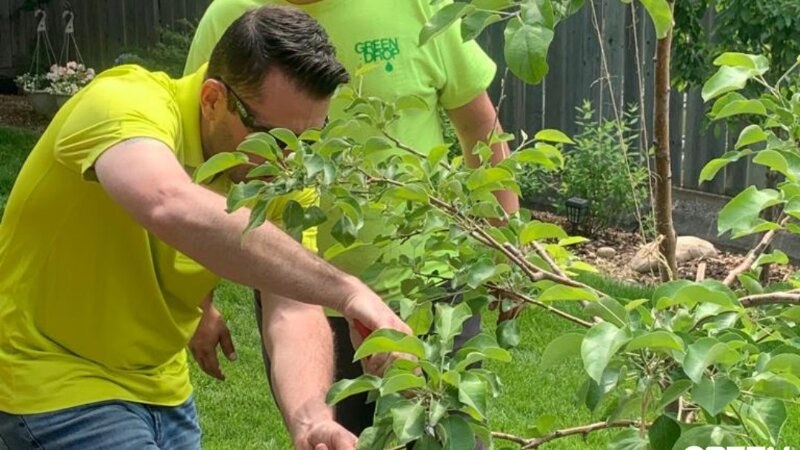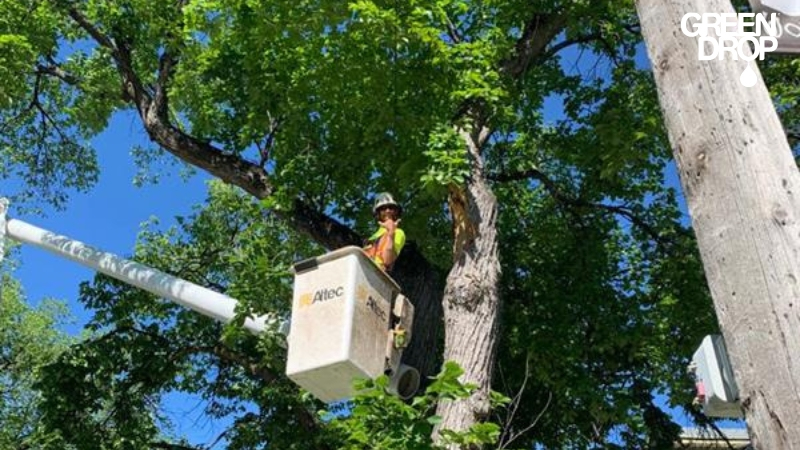You care about your lawn, so you know you need tree pruning that will extend the life of your trees and ensure your outdoor space looks great. Green Drop has assembled a team that knows the ins and outs of tree care, ensuring that you get the best pruning possible.
Our tree pruning services include:
- A free tree assessment so our team understands your yard’s needs.
- Our team of licensed and insured arborists with pruning training.
- Services performed to ANSI A-300 Pruning standards.
- Cleanup and removal of all debris.
Green Drop will help you keep your trees looking their best with careful pruning. Talk to the team and get a free estimate today.
*Service availability may vary by location

Tree Pruning Improves the Lifespan of Your Trees
Caring for your trees sometimes includes understanding when you should remove a damaged or hazardous branch. With tree pruning services, your trees stay looking their best, and you stay safe from any potential damages.
Green Drop has gathered a team of ISA-certified arborists ready to get your yard in shape when you’re ready for pruning services. We’ll work with you to plan the project and asses your trees to ensure they get the care they need.
Our experts are ready to help you when you need tree care and pruning.
What is Tree Pruning?
Tree pruning aims to improve tree lifespan and structure. It is done by removing branches that may be dead, diseased, or damaged. Additionally, pruning can include thinning branches to promote healthier growth and avoid overcrowding.
What Reasons Do People Have to Prune Trees?
People have three major considerations when it’s time to prune a tree. Any of them are valid, though pruning is more significant than tree trimming or cutting and often centers on disease or health concerns.
The three reasons you should prune your trees are:
- Safety – You’ll find safety pruning done when a tree has dead or damaged limbs or grows toward a human structure like utility lines or homes.
- Health – Many arborists will recommend pruning for tree health if a branch is diseased or faces insect infestation. Additional health reasons for tree pruning include removing branches to increase sunlight and availability of nutrients.
- Aesthetics – When pruning for aesthetic reasons, the goal is to boost a tree’s form and structure or stimulate new growth like flowers.
Pruning Techniques
There are several techniques that professionals like the Green Drop team use when pruning. We’ll match the best method to the pruning your yard needs specifically.
The four major types of pruning are:
- Thinning – Removing select branches improves air circulation and sunlight penetration throughout the tree's canopy.
- Raising – Removing lower branches to provide clearance for pedestrians, vehicles, or buildings.
- Reduction – Reducing the overall size of the tree or specific branches to decrease the risk of branch failure or to clear space near structures or utility lines.
- Topping – Removing large branches or a significant portion of the tree's canopy. We generally do not recommend topping due to the stress and damage it can cause.
This isn’t an exhaustive list, so another technique may be recommended, depending on the tree issues you face. That’s why we recommend a free tree assessment from our team to help you make the most informed decisions about tree pruning.
Signs It May Be Time to Prune Your Trees
Knowing when your tree needs pruning can be tricky, but there are many signs you can look for to keep your trees at their best.
Dead Branches
Noticing dead branches is a straightforward way to tell that you have a tree that needs pruning. Signs that a tree limb is dead or dying include a lack of leaves during the growing season, fungus growth all over the branch, or many insects. Another test for live branches is to check how bendable they are.
Overgrown Branches
Keeping an eye out for overgrown branches is essential if you’re worried about the safety of your home or family. It may be time to take care of a branch that’s grown too big if you see it hanging too close to your home, windows, or other liveable structure. Additionally, if you live near power lines, you’ll want to be aware of trees encroaching on that space.
Leaning Trees
This visual sign is another great way to tell that a tree may need pruning. When a tree leans too much, it could be a sign of structural or root issues that must be addressed so the tree doesn’t fall.
Uneven Canopy
When the canopy of a tree is unbalanced, it can be both an aesthetic issue and one that could cause safety issues down the line. If you can tell that one side of a tree has more branches and a larger canopy space, you should consider pruning to balance the tree’s growth and prevent significant structural issues.
Tree Pruning Benefits with Green Drop
If you don’t prune, you risk your space's safety and your trees' long-term health. Regular pruning and tree maintenance have a variety of benefits worth keeping in mind if you’re just starting your tree care journey with Green Drop.
Promotes Better Growth
As a professional tree care service, our team understands the importance of pruning to encourage new and more vibrant growth from your trees. By removing a struggling branch, your tree has more resources for growing new branches that are more attractive and stronger.
Improves Tree Structure
Improving the structure of your trees has two-fold benefits. You can strengthen the tree against extreme conditions like intense storms or snowfall and have a more attractive tree overall. Remembering this while pruning means you’re not at risk of losing branches or an unbalanced weight distribution.
Boost Tree Aesthetics
Great pruning means that your trees stay looking their best. It builds on the previously mentioned benefits because a great structure and better growth mean your tree looks great. Then your lawn has more curb appeal, and you can enjoy the beautiful property you have even more.

Our Process Keeps Your Trees Healthier, Longer
With over 20 years of experience, our experts have honed a process you can count on to get great results year-round. We’ve put together steps that keep you involved as we utilize our expertise to bring you the best-looking trees.
Yard & Tree Assessment
When you work with Green Drop, the first step is a free lawn consultation. We’ll check all of your trees for any issues. From there, we can inform you of our findings to provide you with a plan of attack to get your trees looking their best.
Personalized Recommendations
Since our team examines your yard in its entirety, your arborist will have in-depth information about the type of plants you have and how you use your yard to help provide you with a clear action plan. We’ll detail each step and tell you what we feel is a pressing need before completing any work.
Tree Pruning Service
Any time we provide pruning, we’ll establish the scope of the service needed and prepare you for what you can expect. Our services involve specialized equipment that’s meant to help the process along. Each arborist receives special training to use any equipment necessary safely and accurately to protect your lawn and the health of your trees.
Regular Follow Ups & Maintenance
Depending on the services you need and the plans you choose, we’ll work with you regularly to ensure the longevity and health of each plant in your yard. The goal is that with regular service and preventative services like our RootBoost treatment, you won’t need to prune your trees all the time, but we’ll know and be able to act swiftly if you ever need additional care.
What Time of Year is Best for Pruning?
One of the questions our arborists get asked regularly is when the best time to prune their trees is. There is no one answer to this, as the tree species and its needs change depending on several factors, like insect infestation or susceptibility to disease.
However, most experts agree that the best time to prune is during the winter months. Most deciduous trees go dormant from November through March and shed their leaves.
There are several benefits to pruning during this time, such as saving money by pruning early instead of during the busiest time. One of the biggest reasons is that the trees are less likely to contract a disease or deal with insect infestations.
Additionally, during the winter, pruning can cause less damage to the rest of your yard and makes it easier for our arborists to access every part of your tree without disturbing any leaves. The colder months also give your tree time to recover and heal more quickly, so once spring arrives, your tree will be the healthiest it can be.
Avoid Risks by Choosing a Professional Pruning Service
Working with a professional tree care service gives you access to the knowledge of experts and equipment you don’t have. Instead of risking injury or damage by going it alone, turn to Green Drop for support with pruning.
Sidestep Debris & Hazards
Whether you have a large pruning job or just need help with regular tree maintenance, you'll run into debris, like fallen twigs or branches, in your yard. Our team mitigates the safety hazards of any debris with safe collection. From there, we have more efficient methods of hauling trash away or using a wood chipper.
Safety First
Our team takes significant safety precautions to ensure you and your property remain safe. With the addition of a multi-person crew and equipment geared toward the pruning service, you won’t have to worry about paying to repair damages when you need to care for the health of your trees and general safety.
Arborists Have Specialized Equipment
As a homeowner, you likely weigh the pros and cons of the cost of tree pruning from professionals or doing it yourself. Our team has the top-of-the-line, pruning-specific equipment needed, saving you the time of sourcing the equipment and the expense of purchasing professional pieces you may not need to use regularly. Since our arborists also receive extensive training to use our equipment, there’s no learning curve costing you time or risking your safety.

Get the Healthiest Trees with Green Drop Tree Pruning
Whether you need emergency tree pruning or are looking for regular maintenance, it’s essential to look for a professional service that will keep you in the loop and help your lawn look its best.
We’ve been making beautiful lawns and trees at Green Drop for over 20 years. Our team of ISA-certified arborists utilizes their knowledge of tree care practices with personalized suggestions you can trust.
Need tree pruning now? Talk to the team and schedule a free estimate and yard assessment today.
Tree Pruning FAQs
What branches to cut when pruning?
When pruning, focus on dead, damaged, or diseased branches. You can also cut branches that cross or rub against others. Branches with weak or narrow angles compete with the tree's central stem.
When should a mature tree be pruned?
A mature tree should be pruned as needed to maintain its health, safety, and appearance. Most mature trees should be inspected and pruned every 3-5 years. The timing depends on the tree species and the type of issues it faces.
Should I put something on the tree after pruning?
While it was once common practice to apply wound dressings or tree paint after pruning, current research suggests that it’s usually unnecessary. Trees can naturally seal off wounds and prevent decay, so proper pruning techniques are essential to minimize tree damage.
What should you not do when pruning?
When pruning, avoid:
- Removing too much of the tree's canopy at once (usually at most 25-30%).
- Cutting the branch collar, which is the area where the branch meets the trunk.
- Leaving long stubs after cutting branches.
- Topping or indiscriminately cutting back large branches, which can cause stress and damage the tree.
What does tree crowning mean?
Tree crowning refers to pruning techniques that shape or modify a tree's canopy. This can include thinning, raising, and reduction pruning to improve the tree's overall health, appearance, and structural integrity.
What is the best time to prune trees?
The best time to prune trees is typically during their dormant season, between late fall and early spring. Pruning during this time helps prevent the spread of diseases and allows trees to heal more effectively.
Is pruning the same as trimming?
Pruning and trimming are often used interchangeably. However, pruning typically refers to the selective removal of branches to improve a tree's structure, health, and appearance, while trimming focuses on maintaining or shaping a tree's overall appearance.
What month do you start pruning?
The ideal month to start pruning depends on the tree species and your local climate. Most of the time, you want to prune during the dormant season. This occurs between late fall and early spring or between November and March. Some species, like flowering trees, should be pruned after they’ve finished blooming for the best results. To understand when it’s time to prune, learn about the specific tree species you have.
Where does Green Drop offer tree pruning services?
We’re expanding! Our tree pruning services are now available for residents in Calgary, Edmonton, Red Deer, Regina, Saskatoon, and Winnipeg.


